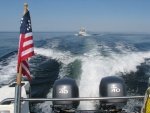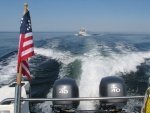hardee
New member
- Joined
- Oct 30, 2006
- Messages
- 12,637
- Reaction score
- 2
- C Dory Year
- 2005
- C Dory Model
- 22 Cruiser
- Hull Identification Number
- Brat # 2202
- Vessel Name
- Sleepy-C
1TUBERIDER":1hsedgnw said:When I am in tight places, I position my helm dead ahead and then split the throttles for directional control.
By all means, with twins, this provides the most maneuverability and control. That 20 or 30 feet this way and that. No sweat, no problem no bumping. Center the wheel, and then use the throttles, forward and reverse, in varying degrees. You can even do a 360 pirquet on the way into the slip, just to check clearances or the sunset or whatever.
Could I do the same with a single, or one of my twins if the other quit. Well, not so gracefully. Remember, slow is your friend. A bump at double dead slow is only a bump. A bump at panic now quick, is not just a bump it is a crash and is going to leave a mark.
Practice with those twins. Spin both ways. Then try holding them in relative positions and move both forward or back together. All kids of fun combinations.
Enjoy/.
Harvey
SleepyC :moon


